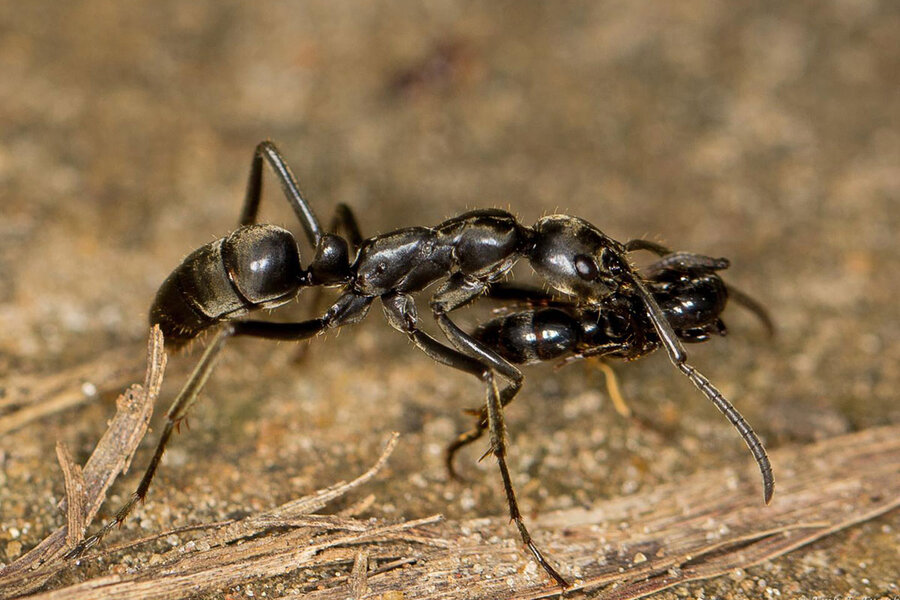First-responder ants suggest helping may be widespread in nature
Loading...
The Matabele ant, an African termite-hunting ant named for a famed warrior tribe, appears to have evolved a soldier's creed of its own: After the battle, leave no ant behind.
In a paper published last week in the journal Science Advances, researchers describe how Megaponera analis ants, a species of large ant known for marching in columns and raiding termite colonies, will, after the battle, pick up injured comrades and carry them back to the nest where they can recover.
The paper is the latest in a growing body of research that suggests that this form of helping behavior, previously observed in some mammals and birds, may not require complex emotion or cognition, and may, therefore, be far more widespread in nature than previously thought. While researchers are reluctant to attribute this behavior to emotions such as empathy or compassion, the idea of ants rescuing each other deepens our understanding of the level of cooperation found among some of Earth's smallest creatures.
"Here we have an example of an individual saving another individual," says lead researcher Erik Frank, a doctoral student at the University of Würzburg in Germany who conducted his research in Ivory Coast's Comoé National Park. "We can be quite certain that the ants don't know why they are doing what they are doing. It's a very instinctive behavior."
It's a behavior that pays off for the colony. Our classic conception of worker ants, who are sterile, is that they are essentially disposable, but Mr. Frank and his colleagues calculated that the practice of rescuing nest mates results in a colony size that is a 28.7 percent larger than it would be had the ants left their fellow soldiers for dead.
"These injured ants are able to recover from their injuries," says Frank. "They are essential for the safety and the betterment of the colony."
When a Matabele ant is injured, as often happens during battles with Pseudocanthotermes spiniger termites, a gland near her mandibles will release two smelly chemicals – dimethyl disulfide and dimethyl trisulfide – that prompt other ants to carry her back to the nest. Indeed, the researchers found that slathering uninjured ants with these chemicals will trigger the rescue behavior, supporting their hypothesis that the ants were acting on pure instinct, not more complex emotions.

Courtesy Erik Frank
"While humans use empathy as a mechanism" to rescue one another, Frank says, "these ants have evolved a different mechanism."
"This kind of rescue behavior has not been known before, though helping is common in ants," says Bert Hölldobler, a sociobiologist and an evolutionary biologist at Arizona State University's School of Life Sciences and one of the world's top experts on social organization among ants.
As Dr. Hölldobler notes, researchers have found many other types of helping behavior among the insects. In 2009, scientists observed Cataglyphis cursor, an ant native to the Mediterranean regions of France, rescuing relatives that had become trapped. When the experimenters ensnared these ants with nylon threads, their nest mates would bite through the nylon thread to free them.
"The colony as a whole is stronger as a result of this behavior," says Karen Hollis, professor emerita of psychology at Mount Holyoke College who worked on that study. "They need these nest mates"
Dr. Hollis, who was part of the ant-entrapment study, says that rescue behavior among ants can be explained through kin selection, an evolutionary strategy in which an organism will reduce its own chances of reproduction to help a relative who shares its genes.
Kin selection acts on all levels of biological complexity, even single-celled protists in cellular slime molds (CSM), individuals who sacrifice themselves so that their relatives may find nutrients.
As a result, says Hollis, "rescue behavior is more common than we thought," citing studies that found that dolphins help other injured dolphins to the surface for air, capuchin monkeys defend each other during intergroup battles, rats free other rats that are trapped, even when there is no reward for doing so, and Mexican jays raise their young cooperatively.
"The more we study rescue behavior in ants and other animals, the more we are going to realize that it's not just limited to the species we've observed so far," says Hollis.
Frank says that helping behavior, like all other evolutionary adaptations, tends to arise wherever it is needed. "If it is beneficial for the species, or the individual, or the colony, it will evolve. It will exist," he says.






